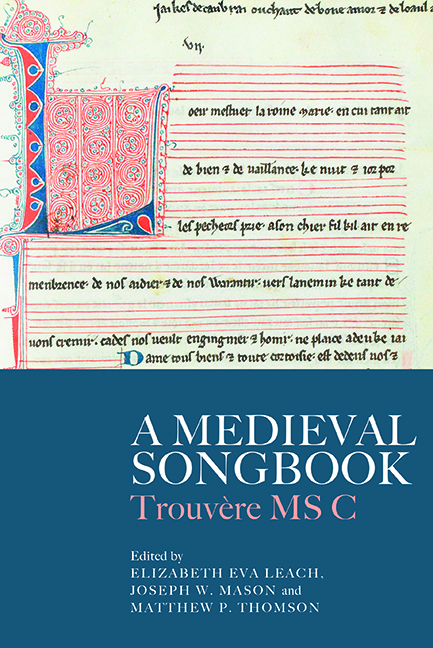Book contents
- Frontmatter
- Contents
- List of Illustrations
- List of Music Examples
- List of Tables
- List of Contributors
- Acknowledgements
- Abbreviations
- Editorial Practices
- Introduction
- Chapter 1 The Trouvère Manuscripts of the Burgerbibliothek Bern
- Chapter 2 The Lorraine Repertoire of C
- Chapter 3 Chansonnier C: Contents, Stemmatic Position, Particularities
- Chapter 4 A Note on the Decoration of C and its Artistic Context
- Chapter 5 Author Ascriptions and Genre Labels in C
- Chapter 6 Common Exemplars of U and C
- Chapter 7 Shared Small Sources for Two Early Fourteenth-Century Metz Chansonniers?
- Chapter 8 The Legacy of Thibaut de Champagne in C
- Chapter 9 Strategies of Appropriation in Jacques de Cambrai's Devotional Contrafacts
- Chapter 10 Jeux-Partis and their Contrafacts in C
- Chapter 11 C and Polyphonic Motets: Exemplars, Adaptations, and Scribal Priorities
- Appendix: List of Songs in C
- Bibliography
- Index of Sources
- Index of Songs
- General Index
- Studies in Medieval and Renaissance Music
Chapter 5 - Author Ascriptions and Genre Labels in C
Published online by Cambridge University Press: 26 May 2022
- Frontmatter
- Contents
- List of Illustrations
- List of Music Examples
- List of Tables
- List of Contributors
- Acknowledgements
- Abbreviations
- Editorial Practices
- Introduction
- Chapter 1 The Trouvère Manuscripts of the Burgerbibliothek Bern
- Chapter 2 The Lorraine Repertoire of C
- Chapter 3 Chansonnier C: Contents, Stemmatic Position, Particularities
- Chapter 4 A Note on the Decoration of C and its Artistic Context
- Chapter 5 Author Ascriptions and Genre Labels in C
- Chapter 6 Common Exemplars of U and C
- Chapter 7 Shared Small Sources for Two Early Fourteenth-Century Metz Chansonniers?
- Chapter 8 The Legacy of Thibaut de Champagne in C
- Chapter 9 Strategies of Appropriation in Jacques de Cambrai's Devotional Contrafacts
- Chapter 10 Jeux-Partis and their Contrafacts in C
- Chapter 11 C and Polyphonic Motets: Exemplars, Adaptations, and Scribal Priorities
- Appendix: List of Songs in C
- Bibliography
- Index of Sources
- Index of Songs
- General Index
- Studies in Medieval and Renaissance Music
Summary
Manuscript C, a complex collection of texts drawn from diverse poetic traditions, is one of the richest trouvère chansonniers. While Christopher Callahan adduces the prevalence of ‘empty staves and pages not ruled for music’ to comment that ‘eastern scriptoria appear to have always been somewhat removed from the centres of lyric practice’, the textual relevance of C remains indisputable, as does that of its sIII family in general. In particular, C often transmits alternate versions of stanzas or whole texts. Such textual instability has been viewed as linked to the tendency in medieval literature for anonymity and different attitudes to concepts of intellectual property. As Olivia Holmes has noted:
Customarily, it was the scribe (or the director of a scriptorium), and not the author, who was responsible for the production of a book, and scribes were not generally concerned with preserving the author's precise words. Content, rather than authorship, appears to have been the most important factor in determining the choice and arrangement of vernacular texts, for attributions were frequently missing. The distinction between author and scribe was not always a clear one, in any case; the medieval writer felt that he or she could legitimately copy or imitate a first-person discourse, substituting his or her own ego for that of the source (what we would consider plagiarism today).
Callahan, too, remarks on C's ‘clear evolution away from the author-centred collections of mid-century’, referring specifically to ‘its principles of organisation’. Not many attributions are available in the sIII manuscripts in general and it seems that C is, and was intended to be, an ‘authorless’ chansonnier, since no rubrics were originally provided. Instead, the songs are gathered alphabetically by incipit, perhaps in order to facilitate the research necessary for the assembly of the volume, for instance by enabling consultation of the texts in an incipitarium. The author ascriptions and genre labels visible in C today were provided by a later rubricator. This article will focus on their remarkable, albeit controversial, testimony.
Author Ascriptions
The rubricator of C suggests a total of 263 attributions. The most represented trouvère is Gace Brulè, to whom thirty-nine texts are assigned: this is not surprising, since more than 100 texts are attributed to him overall in trouvère chansonniers.
- Type
- Chapter
- Information
- A Medieval SongbookTrouvère MS C, pp. 75 - 81Publisher: Boydell & BrewerPrint publication year: 2022
- 1
- Cited by

